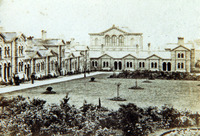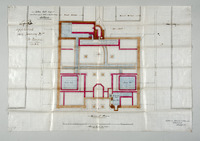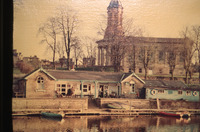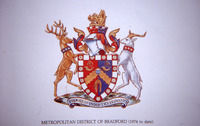Places
Item set
- Identifier
- COL44
- Title
- Places
- Description
- Names of places associated with an item, such as the place of creation, or of use.
- Type
Items
-
Albert Road School buildings, Saltaire, West Yorkshire, United KingdomAs the population of Saltaire grew, the Factory School on Victoria Road (today the Salt Building) became inadequate for the number of children requiring an education. The Salt family provided land on the Western side of Albert Road for the building of a new school for primary education.The local school board opened the Albert Road Board Schools in 1878 to cater for 815 younger children. The original Factory School on Victoria Road remained in use as the High School. The building is still in use and today hosts Saltaire Primary School.
-
 Almshouses, Saltaire, West Yorkshire, United Kingdom Unlike many of his contemporaries, Titus Salt was determined to ensure a decent quality of life for his workers, even after they left his employ. In addition to the many educational institutions he built to allow workers to better themselves, he also commissioned the almshouses on Victoria Road. The 45 almshouses were built to provide shelter for those who couldn’t support themselves, such as widows and injured workers. Although preference was given to workers in Salts Mill and their families, anyone of ‘good character’ and unable to support themselves was eligible. Although this was unusually generous by the standards of the time, residents were subject to strict rules on their behaviour and the maintenance of the houses. In what is now No. 29, there was originally a small chapel to save residents walking down to the Congregational Church. On opening it, Salt is reported to have said: 'My sole desire is that you should be happy, and nothing would give me greater pleasure than to know that you are so'.
Almshouses, Saltaire, West Yorkshire, United Kingdom Unlike many of his contemporaries, Titus Salt was determined to ensure a decent quality of life for his workers, even after they left his employ. In addition to the many educational institutions he built to allow workers to better themselves, he also commissioned the almshouses on Victoria Road. The 45 almshouses were built to provide shelter for those who couldn’t support themselves, such as widows and injured workers. Although preference was given to workers in Salts Mill and their families, anyone of ‘good character’ and unable to support themselves was eligible. Although this was unusually generous by the standards of the time, residents were subject to strict rules on their behaviour and the maintenance of the houses. In what is now No. 29, there was originally a small chapel to save residents walking down to the Congregational Church. On opening it, Salt is reported to have said: 'My sole desire is that you should be happy, and nothing would give me greater pleasure than to know that you are so'. -
Altiplano, PeruThe Altiplano is a high plateau in the northern Andes of South America. Much of the area is in Bolivia but it reaches north into Peru and south into Chile. The Peruvian Altiplano is the home of the alpacas that provided wool for the textile business of Sir Titus Salt.
-
Amerongen, NetherlandsAmerongen is a town in the Utrect province of the Netherlands. The German Kaiser Wilhelm II lived in a castle in Amerongen after he abdicated in November 1918. Isabel Salt has a tin of acorns that (perhaps) were gathered in the Kaiser's garden.
-
Austwick, North Yorkshire, United KingdomSmall rural village in North Yorkshire. Location of the retirement home of Harriet Byles, the second head teacher of the Salts High School for Girls.
-
Avezzano, ItalyCity in the Abruzzo region of Italy. After the Second World War this was one of the areas where people were recruited to work in Britain, particularly in the textile industry.
-
Ayr, Ayrshire, United KingdomAyr is a town on the South West coast of Scotland.
-
 Baildon, West Yorkshire, United Kingdom Baildon is a town near to Saltaire in West Yorkshire. Baildon adjoins Saltaire and Shipley to the north, about 3 miles from Bradford. The Salt and Roberts families owned land and properties in Baildon.
Baildon, West Yorkshire, United Kingdom Baildon is a town near to Saltaire in West Yorkshire. Baildon adjoins Saltaire and Shipley to the north, about 3 miles from Bradford. The Salt and Roberts families owned land and properties in Baildon. -
 Bath and Wash House, Saltaire, West Yorkshire, United Kingdom Titus Salt built the Bath and Wash houses in 1863 at a cost of £7000 (over £600,000 today). These housed 24 baths, 12 each for men and women and a Turkish bath. A warm bath would cost 6d. and a cold one 3d. The wash house contained everything people would need to wash and dry their clothes: 48 washing, rinsing and steam tubs, 48 drying closets, a steam dryer and mangles, meaning clothes could be cleaned and dried in under 1 hour. As in the rest of the North of England, the Bath and Wash Houses did not prove popular. People preferred to bathe in the privacy of their own homes and wash clothes in their own kitchen where they could also complete other tasks. The buildings were converted into houses in the late 1800s before being completely demolished in 1936. Today, a community garden has been planted on the site, following consultation with residents in 2011.
Bath and Wash House, Saltaire, West Yorkshire, United Kingdom Titus Salt built the Bath and Wash houses in 1863 at a cost of £7000 (over £600,000 today). These housed 24 baths, 12 each for men and women and a Turkish bath. A warm bath would cost 6d. and a cold one 3d. The wash house contained everything people would need to wash and dry their clothes: 48 washing, rinsing and steam tubs, 48 drying closets, a steam dryer and mangles, meaning clothes could be cleaned and dried in under 1 hour. As in the rest of the North of England, the Bath and Wash Houses did not prove popular. People preferred to bathe in the privacy of their own homes and wash clothes in their own kitchen where they could also complete other tasks. The buildings were converted into houses in the late 1800s before being completely demolished in 1936. Today, a community garden has been planted on the site, following consultation with residents in 2011. -
Berlin, GermanyBerlin is the capital city of Germany.
-
Bingley, West Yorkshire, United KingdomA town in West Yorkshire, about 6 miles West of Bradford. A traditional market town, it became a site of textile production during the Industrial Revolution.
-
Birmingham, West Midlands, United KingdomBirmingham is a major city in the West Midlands region of the United Kingdom.
-
Blackpool, Lancashire, United KingdomA town in Lancashire on the West coast of England. Blackpool became a popular destination for holidays during the nineteenth century, especially for visitors from West Yorkshire. In 1953 Salts (Saltaire) Limited arranged an outing ofr its entire workforce to celebrate the 100th anniversary of the opening of Salts Mill.
-
 Boathouse, Saltaire, West Yorkshire, United Kingdom The original boathouse was built in 1871. It was eventually converted to a pub. By the turn of the twenty first century the building was derelict. It was taken over, renovated and reopened as the Boathouse Inn. Unlike many buildings in Saltaire, the boathouse is unlisted due to extensive refurbishment and changes to the structure of the building. Nevertheless, it remains an important location in the village for recreation and tourism.
Boathouse, Saltaire, West Yorkshire, United Kingdom The original boathouse was built in 1871. It was eventually converted to a pub. By the turn of the twenty first century the building was derelict. It was taken over, renovated and reopened as the Boathouse Inn. Unlike many buildings in Saltaire, the boathouse is unlisted due to extensive refurbishment and changes to the structure of the building. Nevertheless, it remains an important location in the village for recreation and tourism. -
Boston Spa, West Yorkshire, United KingdomBoston Spa is a village 3 miles south of Wetherby in West Yorkshire, England.
-
Bourton-on-the-Water, Gloucestershire, United KingdomBourton-on-the-Water is a village in the Cotswolds area of Gloucesershire in the south west of England. Bourton-on-the-water is a popular tourist destination and was visited by students from teh Salt Grammar School in 1954.
-
Bracknell, Berkshire, United KingdomBracknell is a town in Berkshire about 25 miles west of London.
-
 Bradford, West Yorkshire, United Kingdom A large cathedral city in West Yorkshire. During the Industrial Revolution Bradford became a major centre for woollen textile production and rapidly grew in size. Titus Salt's original textile business was based in Bradford. By the 1850s the growth in size had resulted in insanitary, poor living conditions for many workers. This prompted Titus Salt to create Saltaire as a model village for his mill and its workers.
Bradford, West Yorkshire, United Kingdom A large cathedral city in West Yorkshire. During the Industrial Revolution Bradford became a major centre for woollen textile production and rapidly grew in size. Titus Salt's original textile business was based in Bradford. By the 1850s the growth in size had resulted in insanitary, poor living conditions for many workers. This prompted Titus Salt to create Saltaire as a model village for his mill and its workers. -
Buenos Aires, ArgentinaCapital City of Argentina
-
Chichester, West Sussex, United KingdomChichester is a city in West Sussex in the south of England.
Catalogue data (excluding media) available under Creative Commons Attribution-ShareAlike (CC BY-SA 4.0) licence.